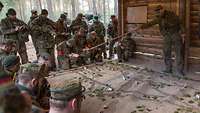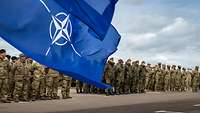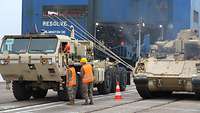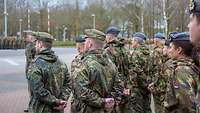Defence and the Bundeswehr: National and Collective Defence
Defence is the Bundeswehr’s most important mission. While national defence focusses on protecting the population in Germany, the Bundeswehr also engages in collective defence in close cooperation with other countries’ armed forces – which may sometimes involve combat on these countries’ territory.

What defence means for the Bundeswehr
On the basis of its mission, the Bundeswehr defends Germany, its citizens and its allies, and takes measures to deter potential adversaries. In addition to defending German territory and taking deterrence, peacekeeping and strategic stability measures, the Bundeswehr also performs the following tasks in accordance with the 2016 White Paper (PDF, 4.3 MB) (PDF, 4,3 MB):
The Bundeswehr and defence: what is national defence?
National defence is direct military defence of the Federal Republic of Germany and its citizens in accordance with Article 87a of the Basic Law for the Federal Republic of Germany. The Bundeswehr uses military and civil capabilities for this purpose. In addition to the active forces, it also mobilises the reserves and services from trade and industry. For national defence, Germany can also count on military assistance from the armed forces of allied countries. This assistance is provided on the basis of international treaties such as the North Atlantic Treaty (for NATONorth Atlantic Treaty Organization) and the Treaty on European Union (for the EUEuropean Union).
The Bundeswehr and defence: what is collective defence?
The Federal Republic of Germany has been a member of the NATONorth Atlantic Treaty Organization alliance since 1955. This community of protection and shared values, which now has 29 members, primarily stands for collective defence of its member nations as stipulated in Article 5 of the North Atlantic Treaty. In this treaty, the NATONorth Atlantic Treaty Organization countries have agreed to provide mutual assistance and take collective action in the event of a conflict.
Germany is also subject to the obligation to provide assistance within the framework of the European Union. Article 42(7) of the Treaty on European Union states that, if a member state is the victim of armed aggression on its territory, all the other member states will provide aid and assistance to this member state using the means within their power.
If a Member State is the victim of armed aggression on its territory, the other Member States shall have towards it an obligation of aid and assistance by all the means in their power, in accordance with Article 51 of the United Nations Charter. This shall not prejudice the specific character of the security and defence policy of certain Member States.
How does the Bundeswehr cooperate with other armed forces for defence purposes?
The Bundeswehr cooperates with other armed forces on many levels. There are two key concepts: host nation support (HNSHost Nation Support) focusses on Germany’s geographic location in the heart of Europe, while the Framework Nations Concept (FNCFramework Nations Concept) pursues military specialisation for the Bundeswehr.
The term “host nation support” refers to support for allied or friendly armed forces in our own country – for example, supporting their missions, exercises or operations. As a transit country for other allied forces, Germany takes on logistic tasks for partner countries. This means that relocation, supply, guarding and coordination are among the core tasks that allied forces from NATONorth Atlantic Treaty Organization and the EUEuropean Union can draw on.
In the Framework Nations Concept (FNCFramework Nations Concept) initiated by Germany, European countries have agreed on targeted further development of selected military capabilities. The concept is based on the idea that one country – known as a “framework nation” – provides the basic military equipment and smaller countries contribute specialised capabilities. NATONorth Atlantic Treaty Organization has three framework nation concepts: a German one, a British one, and an Italian one. There is also a comparable concept at the EUEuropean Union level: the EUEuropean Union Framework Nation Concept.
Which recognised missions is the Bundeswehr involved in?
In addition to international military operations, the Bundeswehr is also involved in recognised missions through its membership in NATONorth Atlantic Treaty Organization. These missions are similar to operations but do not have the same legal status because they have not been approved by the German Bundestag. Through these missions and common NATONorth Atlantic Treaty Organization exercises, the Bundeswehr trains and enhances its operational readiness and the common capability of collective defence. The recognised missions are:
Enhanced Forward Presence – a contribution to collective defence
Following on Russia’s annexation of Crimea, NATONorth Atlantic Treaty Organization adopted the Enhanced Forward Presence programme in July 2016. This programme calls for employment of a multinational battalion known as a “battle group” at NATONorth Atlantic Treaty Organization’s external border in Poland and in each of the three Baltic states, Estonia, Latvia and Lithuania. The Bundeswehr commands one of these formations in Lithuania with around 1,200 military personnel.
Baltic Air Policing – preserving the security of airspace
Baltic Air Policing is a NATONorth Atlantic Treaty Organization mission intended to monitor the airspace of the Baltic states (Estonia, Latvia and Lithuania). Since these three countries joined NATONorth Atlantic Treaty Organization in 2004, various Alliance members have taken on this task on a rotational basis.






